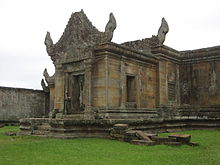UNESCO world heritage
World Heritage is a name for monuments, groups and sites ( World Heritage Site ) and natural formation, geological and physiographical formations and natural sites ( World Heritage ) of outstanding universal value, the identification, protection and preservation by the States Parties to the World Heritage Convention of UNESCO are supported.
According to the implementation guidelines for the World Heritage Convention, cultural and natural heritage are among the inestimable and irreplaceable goods not only of every people, but of all humanity. Because of their exceptional properties, parts of this heritage can be considered of exceptional universal value and therefore worthy of special protection against the ever increasing dangers that threaten them.
The goods worthy of protection are entered in a list that was opened when they were added to the UNESCO cultural and natural heritage in 1978 . The World Heritage Committee decides on inclusion in the World Heritage List .
In Germany, the Conference of Ministers of Education and Cultural Affairs (KMK) decides which sites are nominated by UNESCO for inclusion in the World Heritage List. It has drawn up a handout for the implementation of the UNESCO World Heritage Program with recommendations and leaflets on the importance and handling of existing and potential World Heritage sites.

Origin and basis of the idea
Legal basis
The Convention for the Protection of Cultural Property in the Event of Armed Conflict ( Hague Convention ) set international standards for the preservation of cultural heritage for the first time in 1954.
Basis for the protection of endangered not only by war but also by a spread of civilization cultural heritage and natural sites is in Paris adopted the Convention for the protection of cultural and natural heritage of the world of 16 November 1972, which entered into force 1975th In Germany it was ratified by federal law in 1977. The acceding states undertake to record, protect and preserve the world heritage on their territory themselves. At the same time, they ensure international cooperation and mutual help in fulfilling these tasks.
As of March 2021, 194 member states of the United Nations have joined . The last ratification of the convention was in 2016 by South Sudan and East Timor and in 2020 by Somalia .
expression
The term “cultural heritage” (héritage) goes back to Henri-Baptiste Grégoire , Bishop of Blois and French revolutionary, and was codified in the Hague Convention for the Protection of Cultural Property in the Event of Armed Conflict of May 14, 1954:
"Damage to cultural property, belonging to any people whatsoever, means damage to the cultural heritage of all mankind, since each people makes its contribution to the culture of the world."
"Any damage to cultural property , regardless of which people it belongs to, means damage to the cultural heritage of all mankind, because every people makes its contribution to the culture of the world."

The impetus for the creation of the World Heritage Convention was the call of UNESCO on 8 March 1960 by the construction of the Aswan High Dam on the Nile threatened monuments in Nubia to save for posterity. The temples of Abu Simbel and Philae were demolished and rebuilt 180 m inland at a point 64 m higher. This campaign cost approximately $ 80 million. About half of the funds came from donations from 50 countries. Although Abu Simbel is a facade reconstruction , the monument value of this building was expressly emphasized.
Further security measures were taken, for example, at the lagoons of Venice or the archaeological ruins in Mohenjo-Daro in what is now Pakistan . Together with ICOMOS and IUCN, UNESCO subsequently initiated the development of the World Heritage Convention. In addition, the idea of the wonders of the world , which originated in antiquity, lives on here , which for many centuries fulfilled a similar function for tourism as the UNESCO World Heritage site today. The national and international coordination with regard to military and civil structures for the protection of the world cultural heritage is carried out by the organization Blue Shield International , based in the Dutch city of The Hague .
The protection of the world heritage should also preserve the particularly sensitive cultural memory, the growing cultural diversity and the economic basis of a state, a municipality or a region. There is also a connection between the destruction of cultural assets or world heritage and the cause of flight, as President of Blue Shield International Karl Habsburg-Lothringen explains during a mission in Lebanon in April 2019: “Cultural assets are part of the identity of the people who live in a certain place. If you destroy their culture, you also destroy their identity. Many people are uprooted, often no longer have any prospects and as a result flee from their homeland ”.
At the World Heritage Conference in Brasilia in 2010 it was established that a “dark night sky for astronomy” is also an object worth protecting.
World Heritage Procedure
World Heritage Committee
An intergovernmental committee for the protection of the cultural and natural heritage of exceptional universal value called " Committee for the Heritage of the World " (World Heritage Committee) has been established within UNESCO .
Its 21 members are elected for a specific term by the General Assembly of the Contracting States.
The World Heritage Center , founded in 1992 by Bernd von Droste zu Hülshoff and headed until 1999, is the permanent secretariat of the World Heritage Committee and is organizationally integrated into the cultural sector of the UNESCO Secretariat in Paris. Its task is to implement, record, document and publish the resolutions made by the World Heritage Committee. It organizes the meetings of the General Assembly and the Committee, receives nomination applications for the World Heritage List, coordinates the monitoring of the World Heritage sites and organizes the periodic reporting. It oversees the World Heritage Fund, coordinates international aid projects and supports the contracting states in implementing the goals and programs of the World Heritage Convention.
Three international expert committees to advise the World Heritage Committee: In the field of cultural heritage, these are the International Council on Monuments and Sites ( ICOMOS , International Council on Monuments and Sites) and the International Study Center for the Preservation and Restoration of Cultural Property ( ICCROM , International Center for the Study of the Preservation and Restoration of Cultural Property), in the field of natural heritage, the International Union for conservation of Nature ( IUCN , International Union for conservation of Nature and natural Resources). They take part in the meetings of the World Heritage Committee in an advisory capacity.
Cities on whose territory there is a world heritage have come together to form the Organization of World Heritage Cities , whose headquarters are in Québec .
Support measures for inclusion on the list


It is primarily a matter for each contracting state to record, determine and protect the potential cultural and natural heritage sites located in its territory and to preserve them through financial, artistic, scientific and technical measures. At the same time, the contracting states have recognized that this heritage is a world heritage which the international community as a whole must work together to protect.
Each contracting state can apply to the World Heritage Committee for international support for cultural or natural heritage located on its territory. The committee decides in accordance with Article 11 No. 2 of the World Heritage Convention on the inclusion of new World Heritage sites in the “List of World Heritage” and checks whether the sites already listed still meet the criteria of the World Heritage Convention. It supports the 189 signatory states with technical and material assistance.
According to Art. 20, 22 of the World Heritage Convention, support can be granted for the goods included in the list in the following form:
- Investigations into the artistic, scientific and technical problems raised by the protection, the preservation in existence and value and the revitalization of the cultural and natural heritage;
- Provision of experts, technicians and skilled workers to ensure that the approved work is carried out correctly;
- Training of personnel and specialists at all levels in the field of recording, protecting, preserving the existence and value and revitalizing the cultural and natural heritage;
- Delivery of equipment that the state in question does not own or cannot acquire;
- Low interest rate loans or interest free loans that can be repaid over the long term;
- Granting of lost grants in exceptional cases and for special reasons.
Financial support contributions are granted from the "Fund for the World Heritage", which consists of contributions from the contracting states as well as private donations or bequests and collections for the benefit of the fund. Around 4 million US dollars are available annually for conservation and emergency aid measures at the sites. The World Heritage Committee decides on the allocation of resources from the World Heritage Fund. As a rule, however, only part of the cost of the work required is financed by the fund. The own contribution of the supported state must amount to a substantial part of the funds used for each program or project, unless its funds do not allow this (Art. 25 World Heritage Convention).
Admission procedure
For each year, each contracting state may submit two proposals for inclusion in the UNESCO World Heritage List. However, these proposals must have been on the list of proposals ( tentative list ) for at least two years , which each country stores at UNESCO and regularly updates.
Once a year, usually at the beginning of July, the World Heritage Committee meets to decide on the states' applications for membership. The committee can accept, reject or postpone proposals for the inclusion of sites and request further information from the requesting state. The UNESCO World Heritage List is published continuously.
At its meetings, the committee also advises on the state of preservation of monuments that have already been included. It obtains expert opinions from ICOMOS, IUCN and ICCROM for technical advice. It checks whether a listed monument is threatened or endangered to such an extent that it no longer meets the criteria of the World Heritage Convention and is therefore placed on the list of World Heritage in Danger (so-called Red List ) or is completely deleted from the list. In order to determine any changes in the state of preservation, the sites are regularly checked. In addition, the signatory states must inform the World Heritage Committee of any changes to the sites.
In addition, a protection and conservation plan is required that is sufficient to ensure conservation.
Criteria of protection
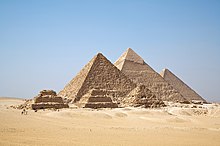

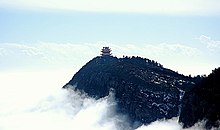
The guidelines for the implementation of the Convention for the Protection of the World Cultural and Natural Heritage contain the criteria according to which a site can be included on the list.
Fundamental is the concept of Outstanding Universal Value ( OUV ) as the central benchmark for the registration of a site. The extraordinary universal value, according to No. 49 of the guidelines, denotes a cultural and / or natural meaning that is so extraordinary that it penetrates national borders and is of importance for both present and future generations of all of humanity. When deciding on inclusion, according to No. 77 ff. Of the guidelines, in particular the overarching criteria of authenticity and intactness are checked (No. 79 to 90 of the guidelines).
Until the beginning of 2005, criteria for cultural and natural assets were kept separately and were numbered separately. Since then, they have been checked together for each property. Although the majority of World Heritage sites are still only designated as cultural heritage or only as natural heritage, as of 2019, 39 sites already meet criteria from both areas.
Heritage criteria:
- The goods represent a masterpiece of human creativity.
- The goods show, for a period of time or in a cultural area of the world, a significant intersection of human values in relation to the development of architecture or technology, large-scale sculpture, urban planning or landscape design.
- The goods represent a unique or at least extraordinary testimony to a cultural tradition or an existing or lost culture.
- The goods represent an excellent example of a type of building, architectural or technological ensemble or landscape that symbolizes one or more significant periods of human history.
- The goods represent an excellent example of a traditional form of human settlement, land or sea use that is typical of one or more specific cultures, or the interaction between humans and the environment, especially when this is threatened with extinction under the pressure of inexorable change.
- The goods are linked in a direct or recognizable way with events or traditional ways of life, with ideas or creeds or with artistic or literary works of exceptional universal importance. (The committee agreed that this criterion should generally only be used in conjunction with other criteria.)
Criteria for natural heritage:
- The goods show outstanding natural phenomena or areas of exceptional natural beauty and aesthetic importance.
- The goods represent exceptional examples of the main stages in the history of the earth, including the development of life, essential geological processes in progress in the development of landforms, or essential geomorphological or physiogeographical features.
- The goods represent exceptional examples of significant ongoing ecological and biological processes in the evolution and development of land, freshwater, coastal and marine ecosystems as well as plant and animal communities.
- The goods contain the most significant and typical habitats for the in situ conservation of biological diversity on earth, including those containing threatened species which, for scientific reasons or for their conservation, are of exceptional universal value.
Protection area
For entry in the world heritage list, the boundaries of the property (that is the actual world heritage site) are clearly defined, which are based on easily recognizable structures. This area is usually surrounded by a buffer zone in order to protect the features that contain the universal value.
In the past, the area of the World Heritage site was also referred to as the “core zone”, but this term is considered out of date and should no longer be used.
Types of World Heritage Sites

According to the criteria listed above, World Heritage sites are divided into:

- World Heritage Sites
- World Heritage Sites
- Mixed world cultural and natural heritage sites
Another subdivision is based on the number of protected objects or areas:
- Simple world heritage sites contain only one object or a closed area, for example Aachen Cathedral , the historical center of Buxoro or the Yellowstone National Park .
- Serial world heritage sites contain several individual objects or several separate areas, for example Arab-Norman Palermo and the cathedrals of Cefalù and Monreale or historical sites of Baekje .
Another subdivision is made according to the number of countries involved:
- National World Heritage Sites only contain objects or areas of a single state
- Transnational World Heritage Sites are serial world heritage sites whose individual objects or areas are located in more than one state, for example The Architectural Work of Le Corbusier or the Western Tian Shan Mountains .
- Cross-border World Heritage Sites are extensive world heritage sites in which a contiguous area extends over several states, for example Fürst-Pückler-Park Bad Muskau , Victoria Falls or the trinational protected area on the Sangha River .
World Heritage Lists
World Heritage List
UNESCO maintains a World Heritage List, on which all World Heritage sites are recorded. As of July 2021, this list includes 1,154 sites in 167 countries. Of these, 897 are listed as world cultural heritage and 218 as world natural heritage, a further 39 sites are listed as mixed cultural and natural heritage sites. 38 World Heritage sites are cross-border or transnational , i.e. assigned to two or more states.
Red List
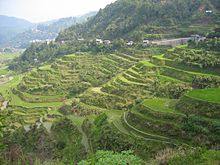
UNESCO is adding acutely endangered world heritage sites to its list of endangered world heritage . It is of secondary importance whether the admission is intended to give those responsible a signal to make more efforts to preserve the goods, or whether a state asks for international support because it is overwhelmed with the protective measures. The aim of inclusion in the Red List is to draw up specific catalogs of measures to restore the value that originally led to inclusion in the World Heritage List. This also applies to the prevention of looting, art theft and conflict-related destruction (bombing, demolitions, graffiti, etc.) and the creation of current inventory lists in museums, archives and cultural sites. UNESCO and its partner organizations such as Blue Shield in association with ICOMOS are active on site for this purpose. As of July 2021, 52 world heritage sites are on the red list, including all world heritage sites in Afghanistan, Libya and Syria.
Deletions
Three sites were finally removed from the list of world heritage sites by 2021:
The first such decision concerned the Arabian oryx wildlife sanctuary in Oman . It was delisted in 2007 after the reserve was reduced by 90% to produce oil there. The oryx population has therefore decreased from 450 to 65 animals since 1996.
The second deleted site is the Dresden Elbe Valley cultural landscape , which was put on the list of endangered world heritage sites in 2006 because of the plans to build the Waldschlößchenbrücke . In 2009 the title was revoked because construction had begun.
The historic port city of Liverpool in the United Kingdom was named as the third deleted site . It was canceled in 2021 because of its endangerment from a planned new construction project that would destroy the historic character of the docks.
Endangering the UNESCO World Heritage status
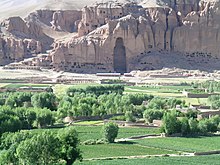
There is no protection guarantee for the listed sites through the World Heritage Convention, at least as long as the signatory states have not decided to transform them into national law . UNESCO has no sanctioning options for violations (with the exception of deletion from the World Heritage List, which, however, does away with the protection goal).
According to a study published in April 2016 on behalf of the WWF, half of the world's natural heritage sites are threatened. This meant a significant increase compared to previous years. The main reason for this is that their protection is subordinated to economic interests. The situation is particularly problematic in Central and South Africa, South and East Asia, the Pacific region, Latin America and the Caribbean. According to an IUCN study from 2021, the greatest risk potential for natural heritage sites is now global warming , which is causing increasing species loss. This can be seen particularly drastically in the Great Barrier Reef off Australia (coral death). The Laponia World Heritage site in Swedish Lapland (temperatures rising disproportionately in the boreal zone ) was classified in the "very high risk" category: after climate change, the immigration of invasive non-native species is in second place and nature tourism is in third place.
Furthermore, the destruction of cultural assets and identity-creating sites is one of the primary goals of modern asymmetrical warfare today. That is why terrorists, rebels or mercenary armies deliberately smash archaeological sites, sacred and secular monuments and plunder libraries, archives and museums. Blue Shield is active to prevent such acts . "No-strike lists" are also drawn up in order to protect the cultural assets from air strikes.
So far, in the vast majority of cases of conflict, a solution acceptable to UNESCO has been found. The relevant willingness to compromise on the part of those responsible in the region exists primarily because they are aware that the title “World Heritage” has a secondary function in addition to its actual (culture and nature preserving) function, namely that of promoting tourism (see also World Heritage in Germany ). However, for example, the destruction of the Buddha statues in Bamiyan (which at that time were not yet listed as World Heritage) could not be prevented by UNESCO protection, nor could the 90% reduction in the size of the wildlife sanctuary of the Arabian oryx (deletion from the World Heritage List 2007 ) in favor of natural gas and oil production.
On the other hand, international attention for world heritage sites is sometimes used as an instrument, because it is hoped for advantages in other conflicts.
Conflicts in Germany
- In July 2004, Cologne Cathedral was added to the Red List of World Heritage in Danger. The city of Cologne initially continued its construction policy in the vicinity of the cathedral. An agreement was finally reached through talks between UNESCO and the city administration: a free zone on both sides of the Rhine will protect the validity of the cathedral from now on, and buildings near the free zone should not exceed a height of 60 meters. Thus the cathedral was removed from the red list in July 2006.
- The Dresden Elbe Valley was entered on the Red List in July 2006 because, according to the expert opinion, the four-lane Waldschlößchenbrücke "irreversibly divides the contiguous landscape of the Elbe arch in two halves at the most sensitive point [...]". After the recommendation of UNESCO to build an Elbe tunnel instead of the bridge was ignored by those responsible for Saxon politics and the bridge was still being built, the Dresden Elbe valley lost the title of "UNESCO World Heritage" by a decision of the World Heritage Committee on June 25, 2009. One New applications for the site with changed boundaries and with reference to other criteria were not excluded.
Monasteries in Kosovo
In 2006, Serbia-Montenegro applied to expand the World Heritage Site of Dečani Monastery , which was named in 2004, to include three further Serbian Orthodox monasteries in Kosovo , which is striving for independence , and to use the title Serbian Medieval Monuments in Kosovo and Metochia for the site in the future . The reason given was, among other things, that the territory of Kosovo and Metohija represented "the center of the medieval Serbian state". They were its "heart - both territorial and spiritual -". Despite being guarded by the KFOR peacekeeping forces, an arson attack was carried out on the Church of the Virgin of Ljeviša in 2004 . In 2006, the World Heritage Committee approved the expansion, but immediately put the site on the Red List and adopted the more neutral name Medieval Monuments in Kosovo . The United Nations Interim Administration Mission in Kosovo is now responsible for protection .
Preah Vihear Temple
In 2008, the Preah Vihear Temple , located on the border between Cambodia and Thailand , was added to the World Heritage List. According to a ruling by the International Court of Justice in 1962, the temple is on the territory of Cambodia. The approval originally given by Thailand to the nomination as Cambodian World Heritage had to be withdrawn after protests by the opposition in the Thai parliament. A few days later, soldiers from both countries moved up on the border. So far there has been no major armed conflict, but isolated incidents have already resulted in the death of some soldiers.
Battir Terraces near Jerusalem
In May 2012, the Palestinians applied to include the Battir Terraces , which are south of Jerusalem on the ceasefire line. Right there, Israel is planning to build a section of a protective fence . In June 2014, UNESCO added the area to both the World Heritage List and the Red List of World Heritage in Danger. In January 2015, the Israeli Supreme Court banned the construction of the wall.
destruction
For the deliberate destruction of a mosque and nine mausoleums in the UNESCO World Heritage City of Timbuktu (Mali), the International Criminal Court in The Hague sentenced the rebel leader of the terrorist militia Ansar Dine Ahmad al-Faqi al-Mahdi to 9 years in prison on September 27, 2016 and on September 17 , 2016 August 2017 for a compensation of 2.7 million euros. The legal basis was Article 8, Paragraph 2 (e) (iv) of the Rome Statute , according to which “also deliberate attacks on buildings dedicated to worship, education, art, science or charity, historical monuments, hospitals and Assembly points for the sick and wounded, unless they are military targets, “ mean a war crime within the meaning of the statute.
World Heritage Day
World Heritage days Worldwide ( English World Heritage Days ) held on different days by different organizations.
The monument protection organization ICOMOS has been celebrating April 18 as the International Day for Monuments and Sites since 1982 .
The World Heritage Day in Germany has been held since 2005 every year on the first Sunday in June. Each World Heritage site hosts a central celebration. Switzerland has put the annual World Heritage Day on the second Sunday of June.
World Wonders Project
In June 2012, the search engine group Google started the so-called World Wonders Project together with UNESCO, the World Monuments Fund , Getty Images and Our Place , in which users can virtually visit 132 world heritage sites in 18 countries using Google Street View images. The offer, which aims to provide a service for the preservation of the world cultural heritage, is enriched with the help of additional explanations, images, 3D models and YouTube videos as well as downloadable teaching material.
See also
![]() Wikipedia: WikiProjekt UNESCO cultural and natural heritage - Wikipedia-internal specialist editorial office on the subject of UNESCO cultural and natural heritage
Wikipedia: WikiProjekt UNESCO cultural and natural heritage - Wikipedia-internal specialist editorial office on the subject of UNESCO cultural and natural heritage
- List of UNESCO World Heritage
- UNESCO cultural and natural heritage : other UNESCO conventions and programs for the preservation and use of cultural assets and natural landscapes
literature
- German UNESCO Commission V., Luxembourg Commission for UNESCO, Austrian Commission for UNESCO, Swiss Commission for UNESCO (ed.): World Heritage Manual. Handbook for the implementation of the World Heritage Convention in Germany, Luxembourg, Austria and Switzerland. 2nd, expanded edition. Bonn 2009, ISBN 978-3-940785-05-3 . ( PDF ).
- Wolfgang Kunth: The UNESCO World Heritage. Atlas & Lexicon. Kunth, Munich 2018, ISBN 978-3-95504-693-4 .
- Florian Pfeifle: The UNESCO World Heritage Site: From Global International Law to Local Infrastructure Planning. Carl Heymanns Verlag, Cologne / Munich 2010, ISBN 978-3-452-27358-1 .
- Andrea Rehling: Universalisms and particularisms in conflict. On the genesis of the UNESCO World Heritage . In: Zeithistorische Forschungen / Studies in Contemporary History 8, 2011, pp. 414–436.
- UNESCO (ed.): The World Heritage. The complete, UNESCO authorized representation of the most extraordinary places on earth. Frederking & Thaler, Munich 2010, ISBN 978-3-89405-776-3 ( The World's Heritage in collaboration with the United Nations Educational, Scientific and Cultural Organization, Paris. Editing: SAW Communications - Eva Gößwein, editorial office Dr. Sabine A. Werner, Mainz).
- Alexandra Jeberien: Ways to an effective application - the instrument “List of World Heritage Sites in Danger” of the UNESCO World Heritage Convention Frankfurt (Oder), Univ.-Diss. 2010.
- Sabine von Schorlemer : Destruction of cultural assets. The eradication of cultural heritage in crisis countries as a challenge for the United Nations. The United Nations and Global Change, Volume 11. Nomos Verlag, Baden-Baden 2016. ISBN 978-3848727872 .
Web links
- Official site of the UNESCO World Heritage Center (English)
- World Heritage List at the German UNESCO Commission
- List of world natural heritage at the IUCN (English)
- World cultural and natural heritage sites in the documentary series Treasures of the World
- World Heritage in the YouTube channel of UNESCO
- National UNESCO commissions: Germany , Austria , Switzerland
Individual evidence
- ↑ Convention for the Protection of the World’s Cultural and Natural Heritage of November 16, 1972 (German version).
- ↑ UNESCO Center for the World Heritage: Guidelines for the Implementation of the Convention for the Protection of the World Cultural and Natural Heritage Final version of June 2, 2017.
- ↑ Handout of the Conference of Ministers of Education of the Federal States on UNESCO World Heritage Resolution of the Conference of Ministers of Education of October 12, 2017.
- ↑ Federal Law Gazette 1977 II pp. 213, 216
- ↑ The UNESCO World Heritage List: Admission Procedure Against the Background of Current Initiatives Scientific Services of the German Bundestag , elaborated on February 16, 2017.
- ↑ List of the acceding states on the UNESCO website , accessed on March 12, 2021 (English).
- ↑ cf. Hans Haider "Abuse of cultural goods is punishable" in Wiener Zeitung of June 29, 2012.
- ^ Karl von Habsburg on a mission in Lebanon. Retrieved July 19, 2019 .
- ↑ Jyot Hosagrahar: Culture: at the heart of SDGs. UNESCO Courier, April-June 2017.
- ^ Rick Szostak: The Causes of Economic Growth: Interdisciplinary Perspectives. Springer Science & Business Media, 2009, ISBN 978-3-540-92282-7 .
- ↑ At its 34th meeting, the UNESCO World Heritage Committee confirmed the study on astronomy and world heritage on the website of the Kuffner Observatory, accessed on August 4, 2010.
- ↑ Criteria quoted according to the guidelines for the implementation of the Convention for the Protection of the World’s Cultural and Natural Heritage (PDF; 468 kB) in the translation of the German Commission for UNESCO, Section II.D., Numbers 77 and 78.
- ↑ UNESCO Center for the World Heritage: Guidelines for the Implementation of the Convention for the Protection of the World Cultural and Natural Heritage Final version of June 2, 2017.
- ↑ a b World Heritage List by category: Mixed Properties. In: https://whc.unesco.org/ . UNESCO World Heritage Center, accessed January 31, 2019 .
- ↑ Creation of world heritage nominations. (PDF; 3.3 MB) World Heritage Handbook. German Commission for UNESCO , 2017, p. 34 , accessed on December 14, 2020 .
- ↑ World Heritage List by category: Cultural Properties. In: https://whc.unesco.org/ . UNESCO World Heritage Center, accessed January 31, 2019 .
- ↑ World Heritage List by category: Natural Properties. In: https://whc.unesco.org/ . UNESCO World Heritage Center, accessed January 31, 2019 .
- ^ World Heritage List: Transboundary. In: https://whc.unesco.org/ . UNESCO World Heritage Center, accessed January 31, 2019 .
- ↑ a b World Heritage across borders. In: www.unesco.de. German UNESCO Commission, accessed on January 31, 2019 .
- ↑ a b World Heritage List. UNESCO World Heritage Center, accessed July 30, 2021 .
- ↑ World Heritage List. German UNESCO Commission, July 30, 2021, accessed July 30, 2021 .
- ↑ Rüdiger Heimlich, Martin Gehlen: Syria: The cultural property is in danger. Kölner Stadt-Anzeiger from August 24, 2012.
- ^ List of World Heritage in Danger. UNESCO World Heritage Center, accessed July 30, 2021 .
- ^ Protecting people through nature - Natural World Heritage sites as drivers of sustainable development. (PDF) WWF, March 31, 2016, accessed June 30, 2016 (English).
- ↑ Every third natural world heritage site in danger. WWF Germany , October 1, 2015, accessed June 30, 2016 .
- ↑ Unesco World Natural Heritage: Environmentalists fear for the world's crown jewels. In: Spiegel Online. April 6, 2016, accessed June 30, 2016 .
- ↑ Klimathot mot världsarven , in Sveriges Natur , No. 1.21, year 112, magazine of Svenska Naturskyddsföreningen, p. 20.
- ↑ Cf. Isabelle-Constance v. Opalinski: Shots at civilization. FAZ from August 20, 2014.
- ↑ See Peter Stone: Inquiry: Monuments Men. Apollo - The International Art Magazine, February 2, 2015; Mehroz Baig: When War Destroys Identity. Worldpost of May 12, 2014; Fabian von Posser: World Heritage sites bombed, cultural treasures hawked. Die Welt from November 5, 2013; Rüdiger Heimlich: Desert City Palmyra: Protect cultural heritage before it is destroyed. Berliner Zeitung from March 28, 2016.
- ↑ Kunibert Wachten : Expert opinion on the visual effects of the 'Waldschlösschenbrücke traffic train' on the UNESCO World Heritage Site 'Elbe Valley Dresden'. (PDF; 3.5 MB) RWTH Aachen University , Chair and Institute for Urban Development and Regional Planning, accessed on May 3, 2015 .
- ↑ Press release of the German UNESCO Commission .
- ↑ Decision and press release by the World Heritage Committee (both in English).
- ↑ Application documents ( memento of March 16, 2014 in the Internet Archive ) (English) for inclusion in the World Heritage, section Proposal for Extension 2006 , original quotations in English.
- ↑ Decision 30COM 8B.54 of the World Heritage Committee (English).
- ^ Judges rule 8-1 that communique with Cambodia unconstitutional ( Memento of February 23, 2009 in the Internet Archive ).
- ^ Troops 'to leave border temple' .
- ↑ Der Standard , Dead in skirmishes on the border with Thailand , April 3, 2009.
- ^ A Palestinian Village Tries to Protect a Terraced Ancient Wonder of Agriculture .
- ↑ Page of UNESCO: Palestine: Land of Olives and Vines - Cultural Landscape of Southern Jerusalem, Battir .
- ^ Israeli Supreme Court rules against separation wall in Battir @ maannews.net / eng, accessed January 17, 2015.
- ^ ICC, The Prosecutor v. Ahmad Al Faqi Al Mahdi, judgment of September 27, 2016 (ICC-01 / 12-01 / 15).
- ↑ Al-Mahdi found guilty of the destruction of cultural heritage before the International Criminal Court in The Hague, German Commission for UNESCO, September 27, 2016.
- ↑ Maximilian Amos: ICC Imposes Nine Years Imprisonment: Historical Judgment Against Islamists Legal Tribune Online , September 27, 2016.
- ↑ International Criminal Court decides: 2.7 million euros in compensation payments for the destruction of cultural property in Timbuktu German UNESCO Commission, August 17, 2017.
- ↑ April 18 - History. ICOMOS, accessed on December 1, 2018 (English).
- ↑ whes.ch: World Heritage Days .
- ↑ World Wonders Project: Google shows us the sights of the world , t3n , accessed on June 13, 2012.






